Abstract
In this study we try to project physical education content with integrated education, inclusive education and interdisciplinary. So for our aim, we made measurements at driving ability for new perspectives of education expressed through integrated education, inclusive education and interdisciplinary. So to work at this age are considered necessary to evaluate the main trends currently learning (integration, interdisciplinarity, etc..). For this we built a set of five tests assessment covering the current trends manifest in contemporary education, such as: Integrated Education, Inclusive Education, Interdisciplinary Education. In conclusions we think the designing teaching in the primary school curriculum for physical education lessons in an interdisciplinary view, contribute in a more pragmatic and effective to achieve the ideal and global educational goals and operational. Also the evolution of modern didactics of physical education noted the tendency to keep some acquisitions of traditional teaching, but still with emphasis currently reconsidering its entire system on the content, forms, methods of education in terms of scientific design curricular.
Keywords: Educationassessmentintegrationinterdisciplinarity
Introduction
"Inclusive education involves an ongoing process to improve the educational establishment, aimed
at exploiting existing resources, especially human resources to support participation in education of all
students within a community." (MEC, UNICEF, 1999, para. 4)
Inclusion indicators are based on data taken from two main sources of information. First it comes
to data resulting from the study those processes that are known to stimulate the participation of students
who were previously excluded or marginalized; secondly, they are taken into account recent data on
efficient processes to improve work at school. (Vlasceanu, 1983; Cojocariu, 2004)
The indicators focus on the following three "dimensions" of school life:
Dimension 1 - Culture - refers to the extent to which inclusive education philosophy is shared by
all teachers in the school and she can be seen by all members community school and everyone who enters
in the school.
Dimension 2 - Strategy refers to placing in the heart of school development inclusive approach so
that all strategies to get through and not be seen as a new strategy that is added to the existing ones.
Ensure that attention to the concept of inclusive education to be present in all aspects of planning school.
Dimension 3 - Practice is about ensuring coverage in both class work culture and inclusive school
policies. Thus, it must ensure that school plans and how they apply - inside and outside the classroom -
encourage participation of all students. (Cucoș 1996; Cristea, 2000)
Interdisciplinary approach in education is needed content, taking into account the structural and
methodological changes like taking in contemporary science and a strong orientation towards a more
interdisciplinary training of human personality to STI integration in a dynamic democratic society.
"Interdisciplinarity is a form of cooperation between different disciplines on an issue whose complexity
can not be captured only through a convergence and a prudent combination of several points of view."
(Cucoş, 2002, p. 245)
The game interdisciplinary teaching is an activity that combines teaching tasks in different areas of
knowledge, in a unitary structure, focused on learning. He prints of teaching dynamic and attractive
induces a state of joy and relaxation that prevents monotony and fatigue and strengthens students'
intellectual and physical energies. (Colibaba, 2007, 1996)
The concept of integrated education strategy acceptable pedagogy distances itself from European
continental approaching Anglo-Saxon. It does not focus on combining inspired methods and means
classical, but on "the application of inspired, original, creative, however, in a new manner, methods and
means old legacy, accepting the even change them. (Ungureanu, 2000).
In essence, the strategies are integrated education "strategies micro-group, active-participative,
cooperative and collaborative partnership involved, organizing and socializing" (Ungureanu, 2000).
(Gherguţ, 2005) reported stresses that lessons based on cooperative learning positively influence
the formation of individual responsibility (students must communicate results in a personal or group
name), direct interaction and interpersonal skills training and small group. They also create a positive
interdependence among students:
They realize that they need each other to achieve the objectives and tasks of the group;
Have resources that must administer jointly;
That the rewards will be shared.
Established itself as a new type of education, flexible, adaptable to the special needs of all
education generally integrated education removal from traditional education. Specific educational
strategies integration are themselves flexible, diverse. (Rata, 2004)
So to work at this age are considered necessary to evaluate the main trends currently learning
(integration, interdisciplinarity, etc.).
In the study of measurements aimed at assessing driving ability for new perspectives of
education expressed through integrated education, inclusive education and interdisciplinary.
To this end, we built a set of five tests assessment covering the current trends manifest in
contemporary education, such as the following tests: (Cojanu, 2009)
Test 1 - Integrated Education - Help him to see
Class III Operational objective: Improve time to 3 seconds
Operational objective class IV: Improve time to 4 seconds
Description: The teams are made up of two children. One is blindfolded and must travel a distance
of 10 meters contretemps, while the other task is to direct children on the edge. Record two performances:
while registered as blind and the time recorded as aid.
Assessment: It is the average of two times and obtain the final performance in seconds. For
effective communication between partners is given a bonus of 2 seconds, by lowering the time recorded.
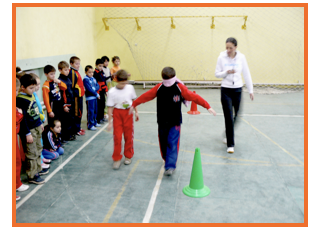
Assessment: It sums up the team recorded during the three movements and then average out the team, which is the performance of each team member. For effective communication between partners is given a bonus of 3 seconds, by lowering the time recorded.
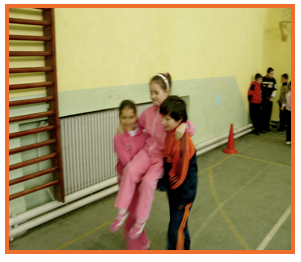
Test 3 - Gifted Education - Who learns faster?
Class III Operational objective: Improve time to 3 seconds Operational objective class IV: Improve time to 4 seconds Description: The test is conducted in pairs. The child has to travel a route contretemps, which is displayed on a billboard. The route is composed of: three steps side left, two steps forward, one step back,
two steps right side, three steps forward, four steps back, three steps left side, two steps forward, one step
back. When the child believes that he learned to run the route goes.
During the cronometrează.
Assessment: The first criterion for evaluation is the place to test and then it is time recorded. For
the place gets a bonus of 10 seconds, and for every mistake is penalized by 2 seconds.
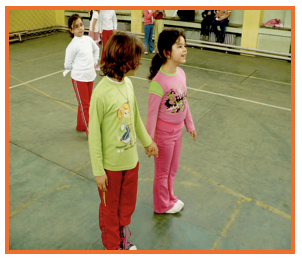
Test 4 - Interdisciplinary Education - Calculates and run more (Dragomir, Scarlat, 2004)
Class III Operational objective: Improve time to 3 seconds
Operational objective class IV: Improve time to 5 seconds
Description: Children have to be done in pairs, running the distance of 10 meters, four times return. At
both ends of the route are four milestones. At the end of where you are only going out landmarks.
the first distance to be a milestone carat, placed over the existing one, back in the running,
returning on its course and bring back the benchmark (4 distance of 10 meters);
the second went the distance to be achieved bank balance on the go gym and reading a stanza
from a poem at first sight (only for class IV), the first child went running and to return other;
the third distance running is made to pull the pole from which a calculation choice. Resolve and
result must be written inside the snail as follows: first child through the snail to the center, the other takes
its place and salt back to the outside equal to result of the counting boxes resolved;
distance have done the last 10 passes with two hands at chest numbers to be loud.
Assessment: It highlights recorded during the four activities. For each correctly performed operation is
given bonus 3 seconds (minus the time recorded) and for each incorrect operation is added to 3 seconds.
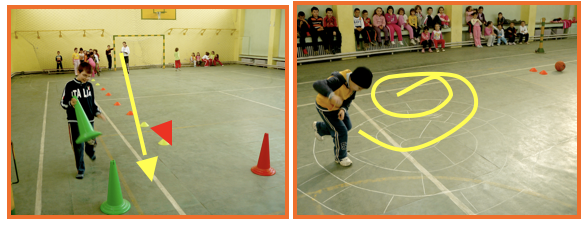
Test 5 - Interdisciplinary Education - Deal with it as soon as
Class III Operational objective: Improve time to 2 seconds
Operational objective class IV: Improve time to 3 seconds
Description: Children have to be done in pairs, running the distance of 10 meters, four times return. At
both ends of the route are four milestones. At the end of where you are only going out landmarks and the
other end of each pole is accompanied by a separate document, whose content is composed of:
A mathematical operation: 7 + 8 =
Words that can form a sentence: morning, wash, face.
Placing of images in order
Draw a: houses, balls, cars, etc..
Assessment: It highlights the time recorded and then the four operations. For each correctly performed
operation is given bonus 3 seconds (minus the time recorded) and for each incorrect operation is added to
3 seconds.
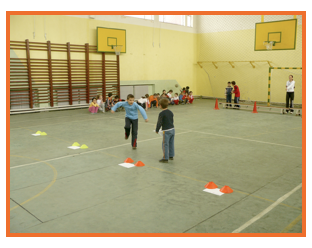
Results
Comparative analysis between groups of control / experiment class for the education profile of the
new perspectives we should note that the following achievements:
We can see that at the final testing, comparative analyze between control and experimental group
at the class III, present significance difference at all tests who build the profile of New ways of education,
with a value of Pearsons correlation between 0,009 spre 0,02.
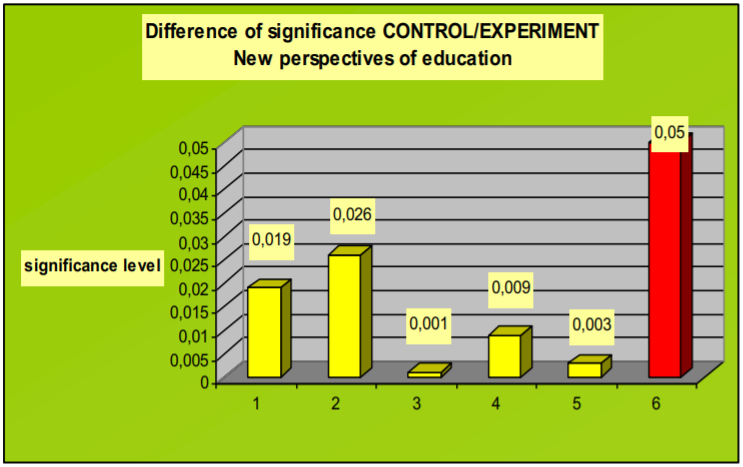
Comparative analysis between groups of control / experiment for class IV profile of the new
perspectives of education we should note that the following achievements:
We can see that at the final testing, comparative analyze between control and experimental group
at the class IV, present significance difference at all tests who build the profile of New ways of education,
with a value of Pearsons correlation between 0,003 spre 0,03.
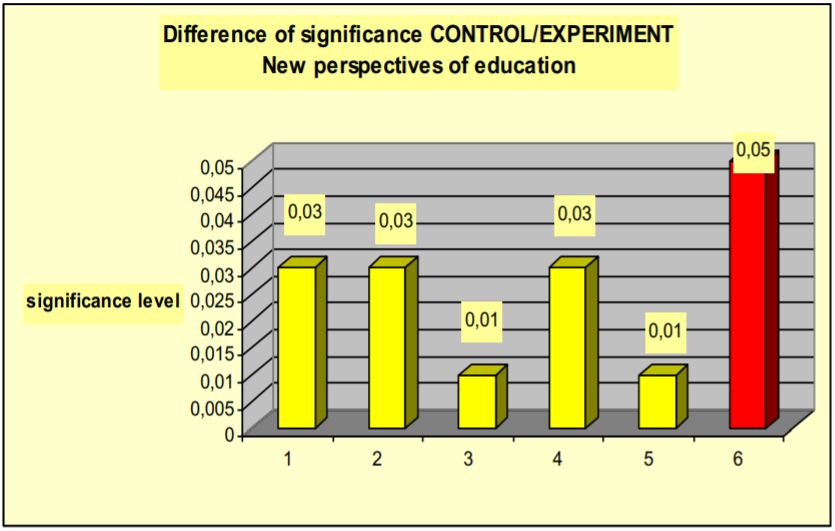
Discussions
We can integrate elements of the particular content of other subjects than physical education, new
motor and cognitive structures in New vision of education opportunities, will allow content to new
coordinated approach: social games, dynamic games, etc.
Combating lack of involvement of the teacher who teaches physical education in terms of design
content only in specific curricula and supplementing it with curriculum objectives and means of other
disciplines (music education, arts education, civic education, etc..)
Conclusions
1. Efficiency problem of the relationship between theory and educational practice in general and
the discipline of physical education in particular, is for us an ongoing subject of optimization by focusing
equal attention to two aspects of teaching, information and format of transferring specific gravity of
educated educated.
2. Designing teaching in the primary school curriculum for physical education lessons in an
interdisciplinary view, contribute in a more pragmatic and effective to achieve the ideal and global
educational goals and operational.
3. The evolution of modern didactics of physical education noted the tendency to keep some
acquisitions of traditional teaching, but still with emphasis currently reconsidering its entire system on the
content, forms, methods of education in terms of scientific design curricular.
4. The practice of initiating the practice of sports or physical activity in leisure time should be
generated from preschool and school children (primary) and the design of attractive and useful content in
real life. This practice will bring high performance sport services, especially sanogenetic will help
increase the nation's potential.
References
- Colibaba, E.D. (2007), Praxiologie and Design, Ed. Universitaria Craiova, p. 69-82.
- Colibaba, E.D. (1996) Designing and implementing teaching science in sport performance, sport In Science, magazine, no. 2
- Cojocariu, V. (2004) Theory and methodology of training, Ed. Pedagogical and didactic, Bucharest, p. 98-133
- Cojanu, F. (2009) Design of interdisciplinary lesson of physical education at the primary cycle, Ed. Pim, Iasi, p. 163-170
- Cristea, S. (2000), Dictionary of Pedagogy, Ed. Point, Bucharest
- Cucos, C (2002), Pedagogy, Issue II, Ed. Polirom Iasi, p. 239-255
- Cucoş, C., (1996), Pedagogie, Iaşi, Editura Polirom, p. 77-79
- Dragomir P., Scarlat E. (2004) - Physical Education school Didactic and Pedagogic Publishing House, Bucharest, p. 69-74
- Gherguţ A., (2005) Summaries of Special Education,Polirom, Iaşi, p. 98-102
- -MEC, UNICEF (1999) Developing inclusive practices in schools, para 4, Bucharest
- Rata G. (2004) - Didactica school physical education, Edit. Alma Mater, Bacau, p. 131-143
- Vlasceanu, L. (1983) Designing pedagogical, I. In Cerghit op. cited, p. 249, Bucharest
- Ungureanu D., (2000) Integrated education and inclusive school, Ed. West Timisoara, p. 45-48
Copyright information

This work is licensed under a Creative Commons Attribution-NonCommercial-NoDerivatives 4.0 International License.
About this article
Publication Date
25 May 2017
Article Doi
eBook ISBN
978-1-80296-022-8
Publisher
Future Academy
Volume
23
Print ISBN (optional)
-
Edition Number
1st Edition
Pages
1-2032
Subjects
Educational strategies, educational policy, organization of education, management of education, teacher, teacher training
Cite this article as:
Cojanu, F., & Visan, P. (2017). New Perspectives of Physical Education With Integrated and Inclusive Education. In E. Soare, & C. Langa (Eds.), Education Facing Contemporary World Issues, vol 23. European Proceedings of Social and Behavioural Sciences (pp. 1415-1422). Future Academy. https://doi.org/10.15405/epsbs.2017.05.02.173

